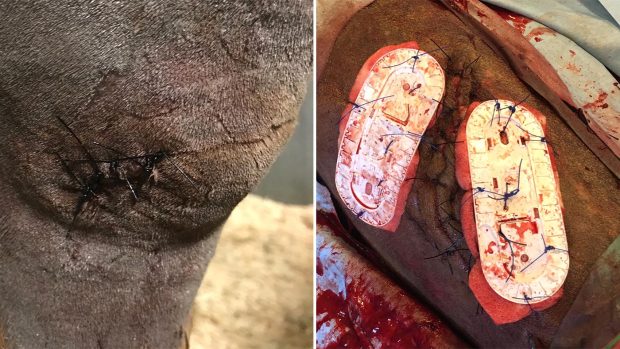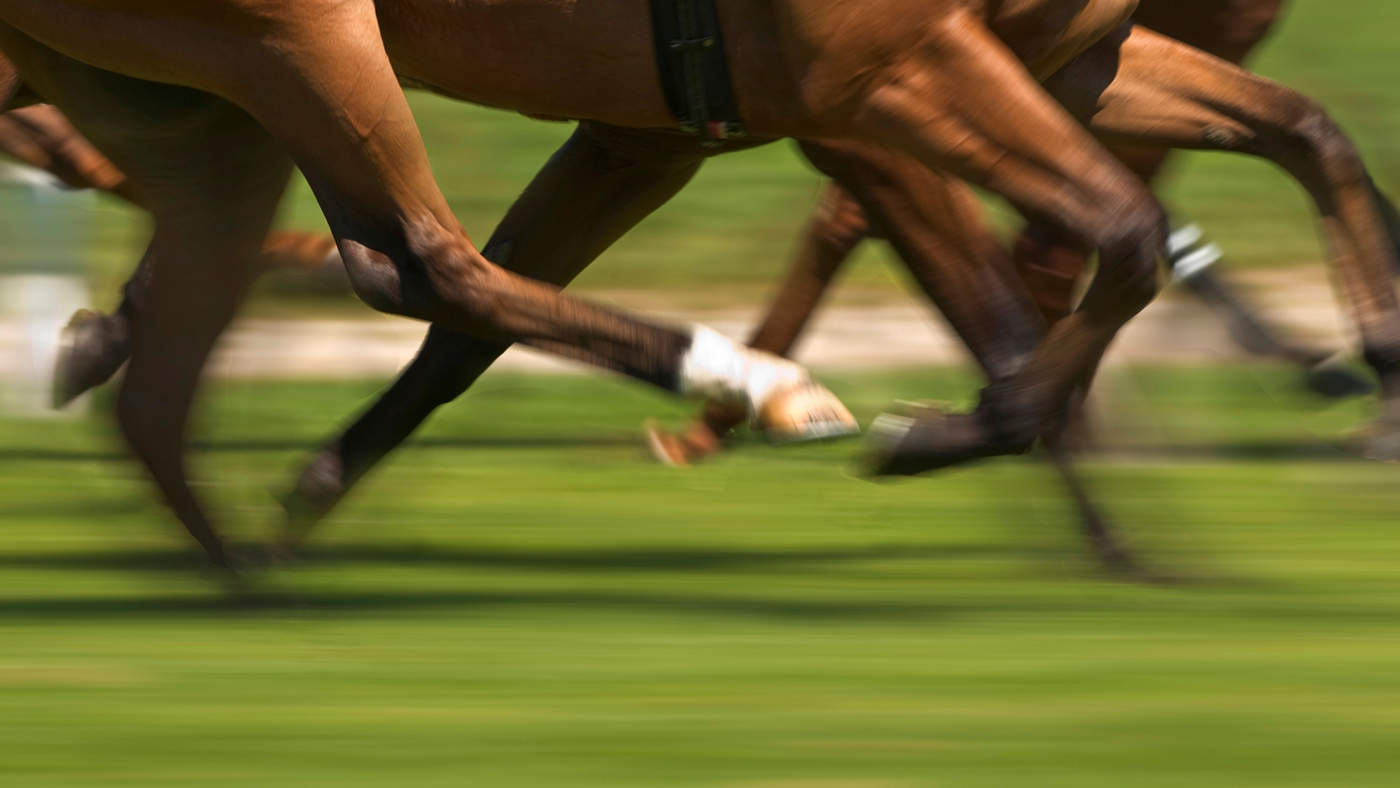Horses’ natural instinct is to move rapidly away from anything that alarms them, often disregarding obstacles such as fences, people or vehicles in their way, which makes them vulnerable to injuring themselves.Typically, they also damage themselves when they become cast in their box, or when they paw at a door or fence .
On the mend
If you think a wound may need to be stitched, speak to your vet as soon as possible, since wounds will heal more effectively if they are sutured while still fresh. Wounds heal from side to side, not from end to end so, even if there is a huge hole, it can heal well.
Also, a little bit of a blood will look like a lot. However, a small amount of bleeding may be beneficial as it will flush out dirt and debris from a wound – severe bleeding must be controlled.
If your horse has severed an artery, bright red blood will spurt out, which can look alarming. Try to stop the bleeding by firmly applying pressure to the wound. Hold a pad of material,such as gamgee, over the wound. As most of these wounds are on the lower limb, a bandage can usually be fastened over the area. If the blood soaks through, put on more padding and apply more pressure.
Cohesive elastic bandages wrapped in several tight turns provide sufficient pressure to reduce the blood supply to the lower leg. This is more practical than the old-fashioned rubber or rope tourniquets and is one occasion when I recommend applying a relatively tight bandage. It should be safe for upto two hours, by which time you should have been able to contact your vet.
Small but serious
The wounds with the most serious consequences tend to be the smallest. The damage caused depends on the wound depth, how dirty it is and whether vital parts of the body are involved. Many first aid manuals tell you to look out for “joint fluid”, and if you see this oily, clear-to-yellow fluid discharging from a wound, you will know that a joint is involved. In reality, a wound is often far too dirty to distinguish this among the blood and muck.
Critical position
The position of the wound may indicate whether it is near a joint or anything else critical, such as the digital tendon sheath at the back of the pastern. Some joints, such as the elbow, are large, so an injury that seems far from the bending part of the joint can still harm it, and infection will spread easily.
If your horse is more lame than you would expect for the size of the wound, suspect serious damage and contact your vet immediately.
Trapped infection
Vital parts of the body, such as tendon sheaths and joints, are poorly designed to cope with infection. All small puncture wounds can cause complications as the infection becomes trapped inside and cannot drain away. If this damage involves a joint, the infection will damage its delicate cartilage lining, producing a septic arthritis and permanent lameness unless it is treated immediately.
Infection within a tendon sheath produces inflammation and scarring which will prevent the limb from bending properly and cause permanent lameness.
Treatment
Aggressive treatment is needed for an effective cure. This usually involves a general anaesthetic and flushing large volumes of fluid through the infected area to clear out the bacteria. The vet may need to do this several times. He may use an arthroscope (a small telescope-like instrument) to visualise and treat the wound. Treatment must be started without delay to ensure a return to soundness.
Foreign bodies
The only advantage of wounds with foreign bodies is that in the majority of cases they are visible, so you know what is wrong. The problem is what to do. In the horrific circumstance of something large, such as the piece of wood in Fujyama’s case being stuck in a wound, it is best left there until the vet arrives, unless it is loose.
In the majority of cases, particularly with wood in the foot, it can be wedged in hard and be difficult and potentially painful to remove. It is better for the vet to remove it as he can give the horse painkillers and sedatives and check the injury properly. The exception is when a nail becomes stuck in the sole of the foot. Remove it to prevent the nail penetrating more deeply and keep the nail. Contact your vet immediately since a deep puncture wound in the foot can have life-threatening consequences.
Leaping back from the brink
A piece of wood lodged in the foot of Tina Fletcher’s mare Fuyjama almost destroyed the show jumper’s successful career. Liz Benwell finds out how quick thinking prevented a catastrophe
Only one word describes how show jumper Tina Fletcher felt when she found her Grade A mare with a foot-long piece of wood embedded in her coronary band – “sick”.
And, when the pair jumped a good clear round at Olympia last December, Tina was still amazed that Andy Doyle’s Finchpalm Fujyama had survived such a horrific injury to be completely sound.
“Unbelievably, she was never lame throughout the whole thing. It just shows how tough she is,” says Tina, who is based in Berkshire with her husband Graham, Horse & Hound’s show jumping columnist.The accident happened when nine-year-old Fujyama was waiting, tacked up, in temporary wooden stabling during the Festival of Show Jumping at Stafford.
“The groom who was looking after her ran to fetch me from the lorry. The mare just stood there with her leg hanging and a piece of wood, about an inch and a half wide and a foot long, going straight down into her foot.”She must have pawed at the door, which didn’t fit well, got her foot under it, pulled back and brought part of it with her. The worst part of it all was deciding whether to try to pull the wood out or call for the vet.”She called for the show vet, who arrived, removed the wood and dressed the wound.Tina then drove Fujyama, who was third in the 1996 Grade C Championship at the Horse of the Year Show, the two hours to her own vets, O’Gorman, Slater and Main in Newbury, Berks.
As soon as Tina arrived, vet Andrew McGonnell flushed out the mare’s wound with a saline solution which produced fragments of wood.
“We X-rayed the foot to make sure that the wood had not damaged the pedal bone or pastern bone,” explains Andrew. “We also took a sample of fluid from the coffin joint to see if the wood had penetrated that. If it had, it would have been catastrophic, but the joint fluid was normal.”
A scan taken while Fujyama was at the surgery, revealed that the piece of wood had missed entering the coffin joint capsule by millimetres.
Andrew describes it as “like something leaning on a piece of cellophane without quite breaking it – it was as close as that”.Had the wood entered the joint capsule, complicated surgery would have been needed. “Treating these things as quickly as possible is an advantage. Tina did the right thing in bringing her mare straight here,” adds the vet.
Sent home with a poulticed foot, the mare was on antibiotics for a week.
“We used an Animalintex poultice and kept replacing it,” says Tina. “After two days, five large splinters came out.”A month’s box rest, followed by a couple of months in the field and Fujyama was back in work – jumping as well as ever.



